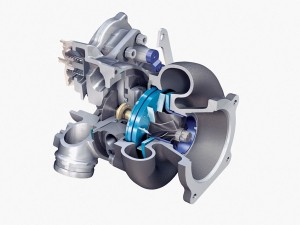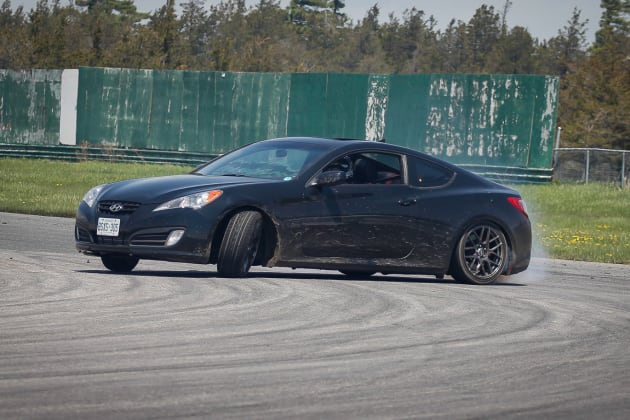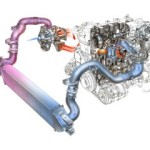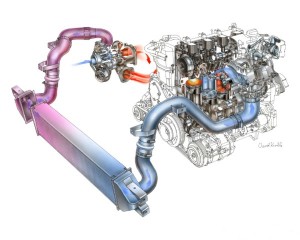Turbochargers are making a comeback, big time! Auto makers are under pressure from the government to boost their Corporate Average Fuel Economy (CAFE) numbers to over 40 mpg by 2021. One of the ways they are going to accomplish this is to downsize engines and add turbochargers to boost performance so smaller engines can still deliver satisfactory power and acceleration. Downsizing engines not only reduces fuel consumption but also reduces carbon dioxide (CO2) emissions (which is important in reducing the impact of carbon emissions on global warming and climate change).
According to some projections, up to 90% of cars and light trucks in the U.S. may be turbocharged a decade from now. Nearly 16% of all new 2013 model year passenger cars’ engines were factory equipped with some type of forced induction system (turbo or supercharger). In Europe, turbos are already used on about 60% of vehicles. Most of these are small turbo diesel engines, but a growing number are also turbocharged gasoline engines. If we are headed in the same direction, it will be a significant change from the types of power plants the auto makers have been building for the past several decades.
Among the domestic auto makers, Ford is leading the charge with its ever-expanding line of EcoBoost engines. (See illustration above). Ford’s 2014 lineup includes a Fiesta with a tiny 1.0L three-cylinder turbo that delivers over 40 mpg on the highway, also a 2.0L turbo Fiesta ST (32 mpg highway), three different turbo options for the Fusion (1.5L, 1.6L and 2.0L), a new 365 horsepower twin-turbo V6 for the F150 pickup, turbo 3.5L engines in the Taurus Police Interceptor, Explorer Sport, Lincoln MKS and MKT, and a new 305 horsepower turbo 2.3L for the 2015 Mustang.
GM is also moving in the same direction with its direct injection Ecotech engine line (some of which are turbocharged and some are not). GM’s newest Ecotech turbo offerings include a turbocharged 1.0L three-cylinder engine with direct injection for the European market, and a turbocharged 1.4L four-cylinder engine for the Chevy Cruze in China. GM’s highly rated 272-hp 2.0L turbo four that delivers 31 mpg highway continues for 2014 in the Buick Regal GS, Cadillac ATS and Chevy Malibu LTZ. There’s also a turbo four available in the Chevy Cruze as well as a turbo diesel engine option.
Not all of GM’s turbos are strictly for fuel economy. The 2014 Cadillac CTS and XTS are available with an optional twin-turbo direct injected 3.6L V6. It’s GM’s most powerful production V6, producing 420 hp and 430 lb.-ft. of torque with 12 lbs. of boost. Fuel economy is rated at 25 mpg highway, which isn’t bad for an engine that can accelerate either car from 0 to 60 mph as fast as a Mustang GT (4.6 seconds).
Turbos are making a comeback at Chrysler, too. Chrysler built a slew of turbo 2.2L and 2.5L engines back in the 1980s and 1990s. In recent years, they had the Neon SRT, Crossfire SRT and PT Cruiser turbo models, followed by a 2.4L turbo Dodge Caliber SRT4. Chrysler also has a turbo four available in its Dodge Dart SRT4, and is developing single and twin turbo variants of a 3.0L V6 for possible introduction in model year 2015 or 2016. The single turbo engine may eventually replace the current 5.8L Hemi V8 in some applications (sorry Hemi fans).
Import automakers are also looking at more turbo options beyond existing performance models such as the Nissan GTR, Subaru WRX, Mitsubishi EVO, Mazda Speed3, plus various BMW, Porsche and VW models, etc. Like the domestic automakers, every car company will have to make a variety of changes to improve their CAFE numbers in the years ahead. Hybrids are one way to go, but turbocharged clean diesels are less expensive than hybrids and give a faster payback. More passenger car diesels are being offered (Jeep and Chevy Cruze), but downsized turbocharged gasoline engines are still considered the most economical way to realize a significant improvement in fuel economy by many automakers.
The typical downsized turbocharged gasoline engine is about 20% more fuel efficient than a naturally aspirated gasoline engine with equivalent power output. A turbocharged diesel engine is up to 40% more efficient than a naturally aspirated gasoline engine.
How Much Power?
The average car only needs about 20 to 30 horsepower to travel down the highway. Extra power is really only necessary when accelerating, merging onto an expressway, passing, climbing a hill or carrying extra weight. This kind of power can be easily provided by a downsized engine with a turbocharger.
Hanging a turbo on a small engine allows a little engine to breathe big. With only 6 to 8 pounds of boost pressure, a turbo can increase power output 15 to 25% or more over a naturally aspirated engine. Consequently, a turbo four cylinder engine be used in place of a larger V6, and a turbo V6 can replace a larger V8 with no loss of performance. Eventually, we’ll see turbocharged three-cylinder engines replacing many four-cylinder engines.
A turbo is exhaust driven and draws no power from the engine as a belt-driven supercharger does. Superchargers can deliver right-now boost at low RPM, but the trade-off is a constant drain on the engine when the extra boost pressure isn’t needed.
A turbo, on the other hand, is just along for the ride and doesn’t develop any boost pressure until the throttle opens and exhaust flow increases. It then spools up and starts pushing more air into the engine. Turbos can rev up to 200,000 RPM or higher, but it can take a few seconds to reach such speeds.
Because of this, engineers design turbo systems so they can reach maximum boost pressure with minimum lag. Using a relatively small turbo allows it to spool up much more quickly and reach higher speeds. Some of the newest turbos are now revving to over 250,000 RPM!
Proper sizing of the turbo is essential to reduce lag. A smaller turbo will spool up more quickly at low engine speeds than a larger turbo, but a large turbo flows more air and develops more boost pressure and power. Since the emphasis now is more on fuel economy than all-out performance, most of the new passenger car turbo engines are equipped with relatively small turbos that deliver just enough boost to offset the smaller displacement of the engine.
Some “variable geometry” turbochargers (also called “variable nozzle” or “variable vane” turbos) have movable vanes that change the “aspect ratio” of the turbo. Aspect ratio is the relationship between the size of the turbo and how much air it flows at various speeds. A turbo with a smaller aspect ratio will spool up faster and deliver more boost at low RPM but may not flow enough air at high RPM. A turbo with a large aspect ratio will flow lots of air and deliver lots of boost at high RPM but will be slow to spool up at low RPM.
Using movable vanes to change the effective aspect ratio of the turbo means the turbo will perform better across a wider range of engine speeds. Closing the vanes at low RPM increases exhaust velocity and spins the turbo faster. Opening the vanes at higher RPMs allows the turbo to flow more air and make more power.
Boost pressure is controlled by a “wastegate.” The wastegate valve opens a bypass circuit that controls how quickly boost pressure builds. It also limits peak boost pressure so the engine doesn’t go into detonation. Too much boost pressure can destroy an engine that isn’t designed to handle it. The operation of the wastegate is controlled by the Powertrain Control Module (PCM), so it is possible to tweak the turbo’s output by reprogramming the PCM.
The boost strategy on most late model engines is to develop boost as quickly as possible and to maintain peak torque output across a broad RPM range. The resulting power curve is much flatter than a comparable non-turbocharged engine, which typically rises in direct proportion to engine speed and peaks out around 5000 to 5500 RPM before dropping off. The boost pressure created by a turbo can bring the power curve up quickly by 2500 RPM and keep it relatively flat all the way to the engine’s redline.
The Cadillac Twin-Turbo 3.6L V6 is a power-dense six-cylinder engine in the midsize luxury segment – producing 420hp and 583 (430 lb-ft) of torque at 2,500 RPM.
Turbo Tweaks
Aftermarket “tuner” scan tools have been a popular toy for reprogramming turbocharged engines as well as non-turbo engines. Most of these tools provide one of several different calibrations that alter the stock fuel mixture, ignition timing, boost pressure and rev limiter settings. Some tools allow the user to play around with the settings (which can be dangerous if you don’t know what you’re doing), while others provide one of several preprogrammed performance tunes. Most of the tool suppliers can also provide custom tunes based on other engine modifications that have been made (such as exhaust system modifications, different cam, heads, induction system, throttle body, etc.).
A word of caution regarding the use of tuner tools on diesel pickup truck engines – Many of these tools can provide an extra 100 to 150 horsepower for towing, pulling or showing off. Even so, GM recently announced that it will NOT honor engine or drivetrain warranty claims on trucks that have been modified with a performance tuner. GM says its engines are designed for a specific amount of turbo boost pressure, and that increasing boost may result in engine or drivetrain damage. A modified tune can always be returned back to the stock settings, but doing so leaves telltales in the PCM that a dealer can check to see if the PCM tune has been changed.
Dialing up the boost pressure is a quick and easy way to increase power in any turbo engine – up to a point. The stock fuel injectors in many diesel engines can safely handle higher boost pressures but that’s usually not the case with gasoline engines.
The flow capacity of the stock injectors in a gas engine can quickly max out if turbo boost is increased more than a few pounds beyond stock levels. This may cause the fuel mixture to go dangerously lean, resulting in detonation, melted pistons or a blown head gasket. To prevent such a disaster from happening, the flow rate of the injectors have to be matched to the boost pressure and airflow delivered by the turbo. Consequently, if you want to dial up the boost pressure for more power, you’re going to need a set of higher flow injectors.
In gasoline engines, more octane is also needed as boost pressures go up. The engine’s knock sensor can back off timing and boost pressure if detonation is detected, but that also kills performance. Most turbo engines recommend premium fuel because the higher octane helps the air/fuel mixture resist detonation. Premium pump gas is usually only available with octane ratings of 91 or 93, so higher octane racing gas or alcohol (methanol or ethanol) may be needed if turbo boost pressures are increased beyond stock.
The bottom end of most turbo engines is strong enough to handle a moderate increase in boost pressure over stock. But for a real killer street or race engine that’s running lots of boost, stronger pistons, connecting rods and crankshaft are probably going to be a must.
Turbo Maintenance
One thing all turbos need to survive is good lubrication and cooling. The turbine and compressor wheels are mounted on a shaft that is supported by water-cooled bearings in a center housing. The bronze shaft bearings are pressure lubricated and must have a steady supply of oil to handle the high shaft speeds. Synthetic oils are best for turbos because they can handle higher operating temperatures. Regular oil and filter changes are also essential to prevent viscosity breakdown, varnish deposits and sludge that can damage the turbo’s shaft bearings.
Turbo Troubles
The most common problem with high mileage turbos is bearing wear, although blade erosion can also be an issue if the vehicle has an ill-fitting, damaged or missing air filter. Turbine wheel damage in the turbo housing can also occur if an engine has had a valve or piston failure and shrapnel exited an exhaust port.
Noise such as whistles or hisses can be caused by air leaks in the turbo housing, connections or plumbing. Squealing or scraping sounds can be caused by bad shaft bearings or the wheels inside the turbo scraping against the housing. Oil inside the compressor housing would tell you the shaft seals are leaking.
Bad turbo shaft bearings can reduce turbo speeds and boost pressure, or they may cause the turbo to stop spinning altogether. A good turbo should spin freely with no drag, scraping or noise when spun by hand. Any wheel-to-housing interference will create drag and prevent the turbo from reaching normal speeds.
Wheel end play is also critical. The back and forth movement (axial play) of the wheels in the turbo housing should usually be less than .0035 inches. More play would tell you the turbo needs to be rebuilt or replaced.
The turbo center housing that contains the bearings and shaft assembly can be replaced separately, but most remanufactured turbos are sold as complete units with both wheel housings preinstalled. Balance is absolutely critical in a turbo because of the speeds at which they operate. If a compressor or turbine wheel is damaged or bent, it can upset the balance.
If a new wastegate is not included with a replacement turbo, it should also be changed on a high mileage vehicle. Additional parts that may be needed with a turbo replacement include hoses and clamps, and an oil and filter change. Make sure the oil and coolant lines that feed the turbo are clear and flowing normally to prevent a repeat turbo failure.
Turbo control issues can be caused by the solenoid that regulates vacuum to the turbo wastegate, a faulty wastegate, MAP or MAF sensor problems, or even a plugged catalytic converter that creates excessive backpressure.

A turbocharger utilizes a single-stage radial-flow or “centrifugal” compressor (air pump), as seen on the left of this cutaway from Borg-Warner.
New Turbo Technology
Two-stage turbos are now being used in some European engine applications. The twin-turbo setup uses a small turbo for low RPM boost, and a larger secondary turbo to deliver increased airflow at higher engine speeds. Multi-stage turbos are also used on many large diesel engines to boost power.
Although it doesn’t affect production vehicles, advances in racing technology often filter down to everyday production engines.
For the 2014 racing season, rule changes in Formula 1 racing now require teams to use downsized turbocharged 1.6L V6 engines instead of the previous naturally aspirated 2.4L engines. The new turbo engines use less fuel and produce around 600 hp, which is less than the 750 hp produced by the larger naturally-aspirated engines.
The difference in power is made up by using an electronic energy storage system that can deliver an extra burst of power (about 80 hp) for a short period of time, keeping overall performance about the same as before.
The energy storage system uses the exhaust side of the turbo like a generator to recover and store energy during deceleration and at high RPM when the turbo generates more power than the engine needs. The energy is stored in a battery/capacitor setup. When the driver hits the accelerator pedal, the energy storage system discharges and spins up the compressor side of the turbo to create instant boost pressure. Another difference is that the new F1 turbos don’t use a wastegate to limit boost pressure. The energy storage unit controls the speed of the turbo, speeding it up or slowing it down as needed to change boost pressure.
Several companies are also working on electrically-driven turbochargers, including “hybrid” turbos similar to those used on the F1 race cars, as well as electrically-driven centrifugal superchargers that provide boost pressure without using exhaust flow or a belt drive to spin the compressor wheel.
As we move forward with more and more turbo engines, the opportunities to rebuild and modify these engines will continue to grow. Some see this as a niche opportunity for engine builders who specialize in turbos, while others see it as an expanding market opportunity for shops that have to service any kind of engine that comes in the door.
The post Turbochargers: Small Engine Performance Future appeared first on Engine Builder Magazine.
Read more here: Engine Builder Magazine




















